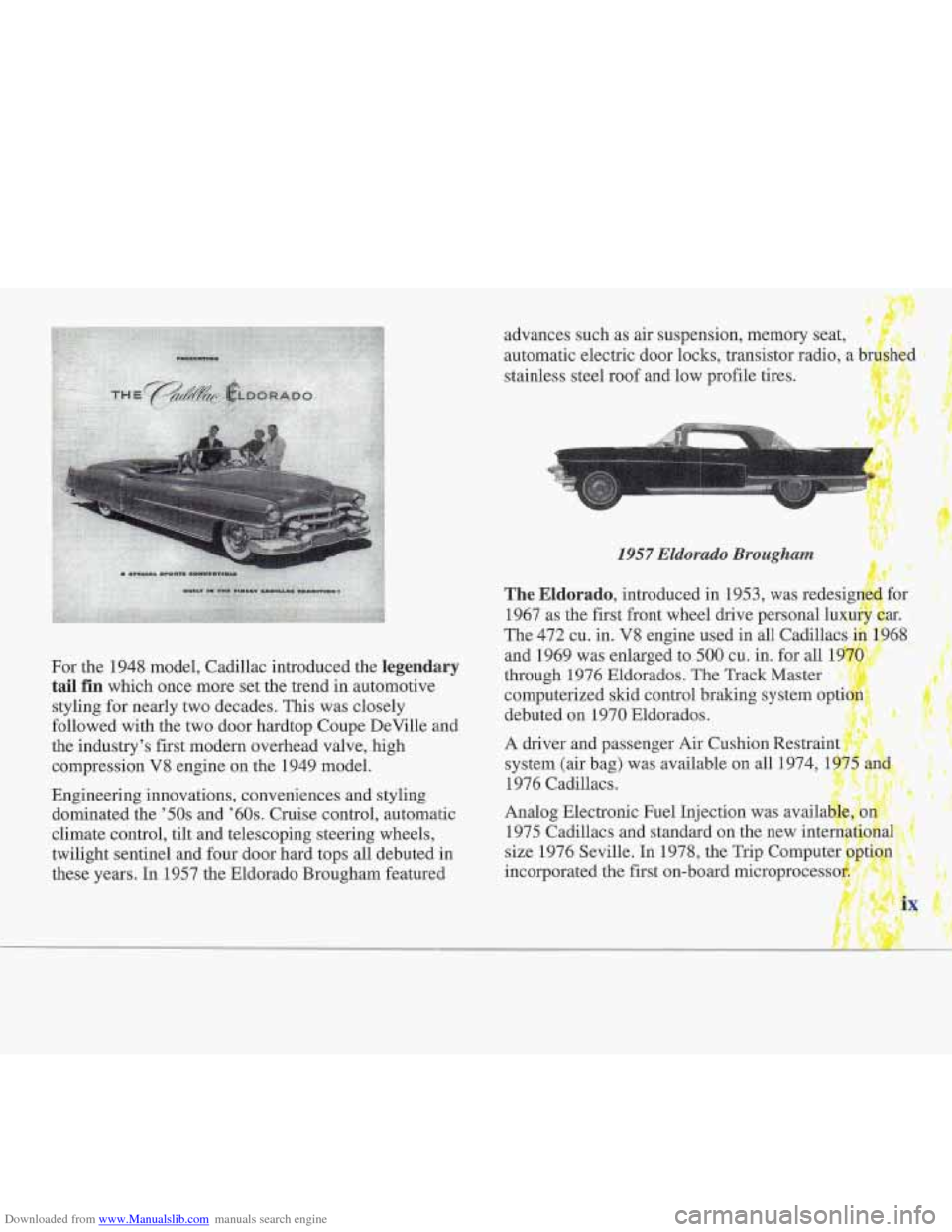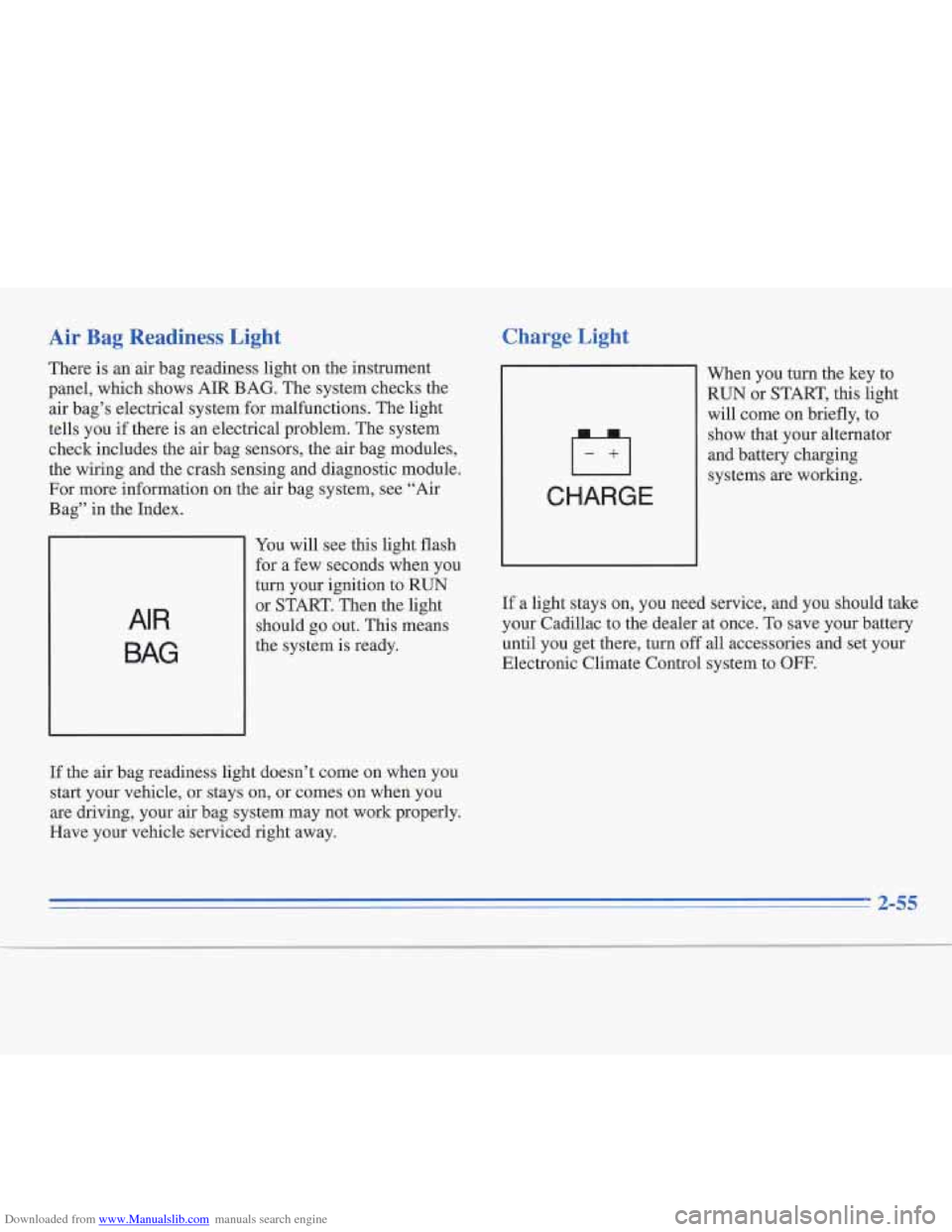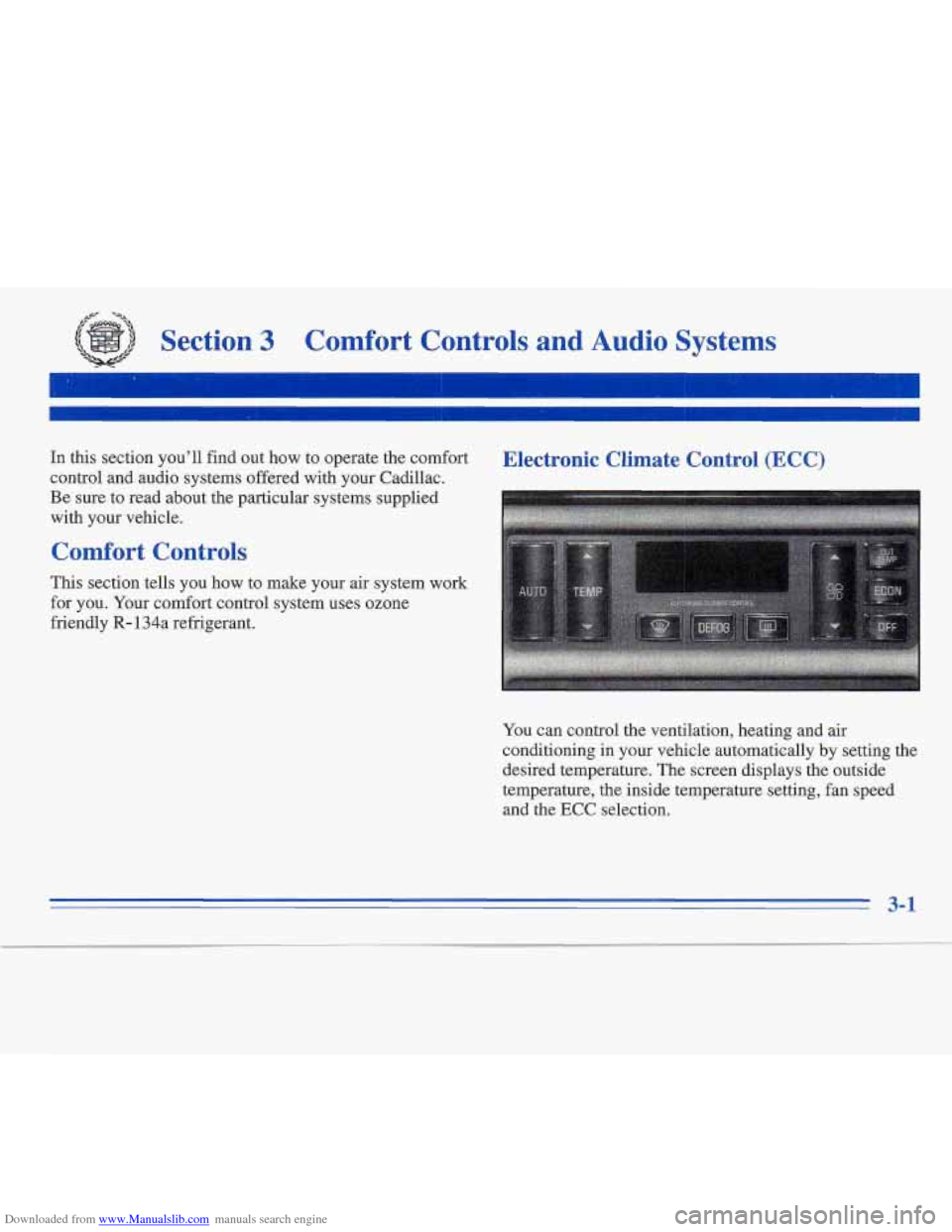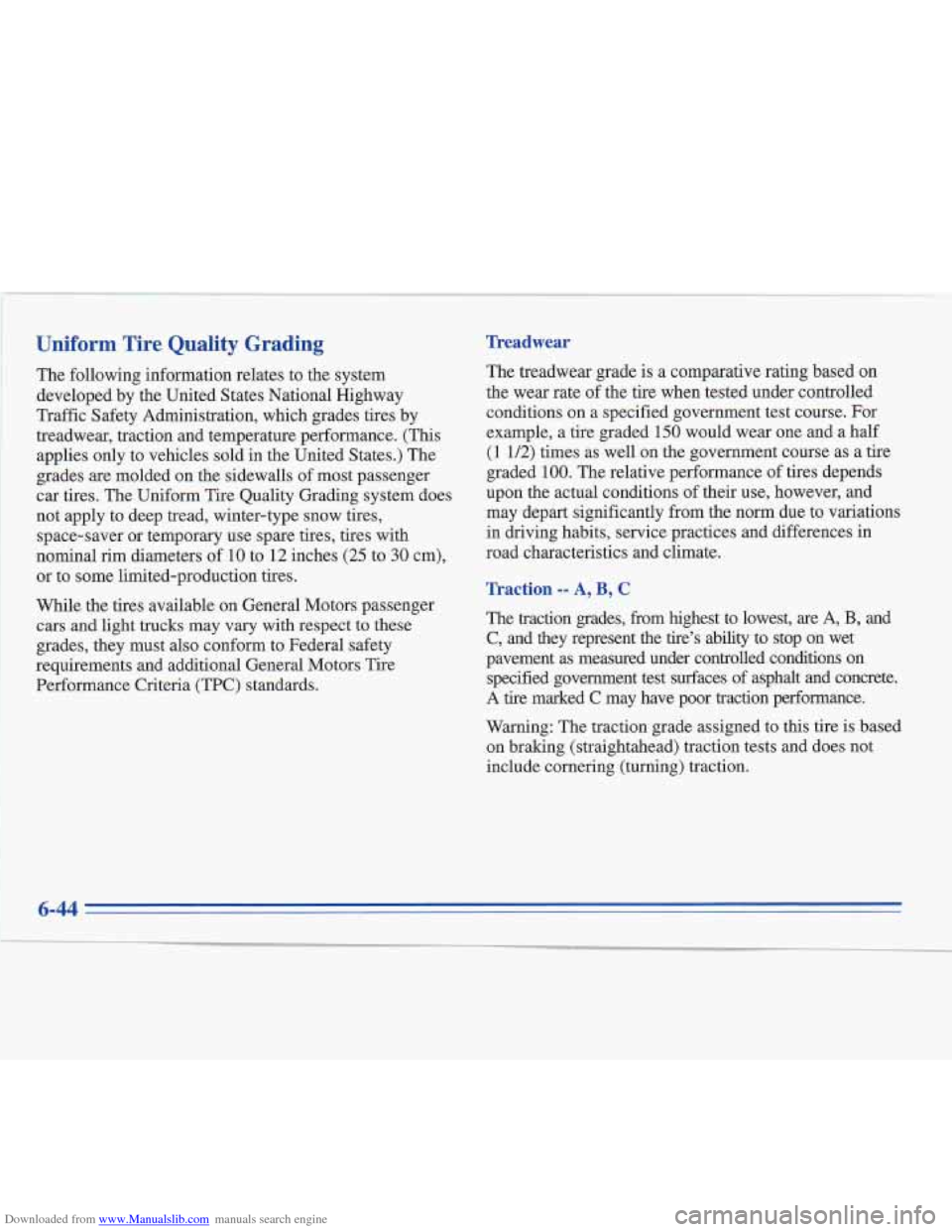1995 CADILLAC FLEETWOOD climate control
[x] Cancel search: climate controlPage 10 of 306

Downloaded from www.Manualslib.com manuals search engine advances such as air suspension, memory seat, '
automatic electric door locks, transistor radio, a b;
stainless steel roof and low profile tires.
I
~ ....
For the 1948 model, Cadillac introduced the legendary
tail
fin which once more set the trend in automotive
styling for nearly
two decades. This was closely
followed with the two door hardtop Coupe DeVille and
the industry's first modern overhead valve, high compression V8 engine on the 1949 model.
Engineering innovations, conveniences and styling dominated the
'50s and '60s. Cruise control, automatic
climate control, tilt and telescoping steering wheels,
twilight sentinel and four door hard tops all debuted in
these years. In 1957 the Eldorado Brougham featured
1957 Eklorado Brougham
The Eldorado, introduced in 1953, was
1967 as the first front wheel drive perso
The 472 cu. in. V8 engine used in all Cadilla
and 1969 was enlarged to
500 cu. in. for all 1
through 1976 Eldorados. The Track Ma
computerized skid control braking
sys
debuted on 1970 Eldorados.
A driver and passenger Air Cushion Restraint
system (air bag) was available on all 1974,
1
1976 Cadillacs.
Analog Electronic
Fuel Injection was
1975 Cadillacs and standard on the ne
Page 114 of 306

Downloaded from www.Manualslib.com manuals search engine Air Bag Readiness Light
There is an air bag readiness light on the instrument
panel, which shows AIR BAG. The system checks the
air bag’s electrical system for malfunctions. The light
tells you if there is an electrical problem. The system
check includes the air bag sensors, the air bag modules,
the wiring and the crash sensing and diagnostic module.
For more information on the
air bag system, see “Air
Bag” in the Index.
AIR
BAG
You will see this light flash
for
a few seconds when you
turn your ignition to
RUN
or START. Then the light
should go out. This means
the system is ready.
If the air bag readiness light doesn’t come on when you
start your vehicle, or stays on, or comes on when you
are driving, your air bag system may not work properly.
Have your vehicle serviced right away.
Charge Light
1+1
CHARGE
When you turn the key to
RUN or START, this light
will come on briefly, to
show that your alternator
and battery charging
systems
are working.
If
a light stays on, you need service, and you should take
your Cadillac to the dealer at once. To save your battery
until you get there, turn
off all accessories and set your
Electronic Climate Control system to
OFF.
2-55
Page 128 of 306

Downloaded from www.Manualslib.com manuals search engine ,+- -%
Section 3 Comfort Controls and Audio Systems
In this section you’ll find out how to operate the comfort
control and audio systems offered with your Cadillac.
Be sure to read about the particular systems supplied
with your vehicle.
Comfort Controls
This section tells you how to make your air system work
for
you. Your comfort control system uses ozone
friendly
R- 134a refrigerant.
Electronic Climate Control (ECC)
I
You can control the ventilation, heating and air
conditioning
in your vehicle automatically by setting the
desired temperature. The screen displays the outside
temperature, the inside temperature setting,
fan speed
and the
ECC selection.
3-1
Page 261 of 306

Downloaded from www.Manualslib.com manuals search engine Uniform Tire Quality Grading
The following information relates to the system
developed by the United States National Highway
Traffic Safety Administration, which grades tires by
treadwear, traction and temperature performance. (This applies only to vehicles sold in the United States.) The
grades are molded on the sidewalls
of most passenger
car tires. The Uniform Tire Quality Grading system does
not apply to deep tread, winter-type snow tires,
space-saver or temporary use spare tires, tires with
nominal rim diameters of
10 to 12 inches (25 to 30 cm),
or to some limited-production tires.
While the tires available on General Motors passenger
cars and light trucks may vary with respect to these
grades, they must also conform to Federal safety
requirements and additional General Motors Tire
Performance Criteria (TPC) standards.
Treadwear
The treadwear grade is a comparative rating based on
the wear rate
of the tire when tested under controlled
conditions on a specified government test course. For
example, a tire graded 150 would wear one and a half
(1 1/2) times as well on the government course as a tire
graded 100. The relative performance of tires depends
upon the actual conditions
of their use, however, and
may depart significantly from the norm due to variations
in driving habits, service practices and differences in
road characteristics and climate.
Traction -- A, B, C
The traction grades, kom highest to lowest, are A, B, and
C, and they represent the tire’s ability to stop on wet
pavement as measured under controlled conditions on specified government test surfaces of asphalt and concrete.
A
tire marked C may have poor traction performance.
Warning: The traction grade assigned to this tire is based
on braking (straightahead) traction tests and does not
include cornering (turning) traction.
Page 297 of 306

Downloaded from www.Manualslib.com manuals search engine Brake Adjustment
.................................. 6-30
Fluid
....................................... 6-26
Master Cylinder
.............................. 6-26
Parking
..................................... 2-22
PedalTravel
................................. 6-30
Replacing System Parts
........................ 6-30
System Warning Light
......................... 2-56
Trailer
...................................... 4-37
Wear
....................................... 6-29
Brake
to Shift Light ............................. 2-65
Brakes, Anti-Lock
............................... 4-6
Braking
........................................ 4-5
Braking
in Emergencies .......................... 4- 10
Break-In, New Vehicle
.......................... 2-14
Bulb Replacement
.............................. 6-3 1
Capacities and Specifications
.................... 6-63
Carbon Monoxide
.................... 2.27.4.28. 4.35
Cassette Tape Player
......................... 3.5. 3.8
Cassette Tape Player Care
........................ 3-17
CD Player Theft-Deterrent Feature
................. 3- 13
Center Front Passenger Position
................... 1-24
Center High-Mounted Stop Lamp
.................. 6-37
Center Rear Passenger Position
.................... 1-29
Certification Label
.............................. 4-30
Chains. Safety
................................. 4-37
Chains. Tire
................................... 6-47
ChangeOilLight
............................... 2-64
Changing a Flat Tire
............................. 5-20
ChargeLight
.................................. 2-55 Check
Engine Light
............................. 2-60
Checking Your Restraint Systems
.................. 1-44
Chemical Paint Spotting
.......................... 6-54
Child Restraints
................................ 1-32
Securing in the Center Rear Seat Position
.......... 1-36
Securing in the Rear Outside Seat Position
......... 1-34
Securing in the Right Front Seat Position
.......... 1-38
TopStrap
................................... 1-33
Wheretoput
................................ 1-32
Cigarette Lighter
............................... 2-46
Circuit Breakers and Fuses
....................... 6-58
Cleaner, Air
................................... 6-14
Cleaning Aluminum Wheels
............................ 6-53
Fabric
...................................... 6-49
Glass
....................................... 6-51
Inside of Your Cadillac
........................ 6-48
Instrument Panel
............................. 6-51
Leather
..................................... 6-51
Outside of Your Cadillac ....................... 6-52
Stains
...................................... 6-49
Tires
....................................... 6-54
Vinyl
....................................... 6-50
Weatherstrips
................................ 6-52
Wheels
..................................... 6-53
Windshield and Wiper Blades
................... 6-52
WoodPanels
................................. 6-51
Climate Control System
........................... 3-1
Clock. Setting the ................................ 3-4
Comfort Controls
................................ 3-1
Compact Disc Care
............................. 3-17
Special Problems
............................. 6-50